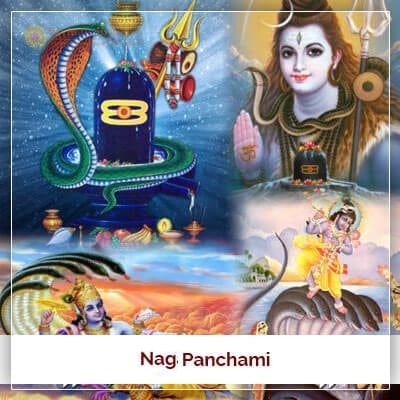Nag Panchami Vrat
Published On : July 6, 2022 | Author : Astrologer Pt Umesh Chandra Pant 
Nag Panchami A Unique Festival
One of the unique festivals in our cultural history, Nag Panchami is an apt depiction of kindness and benevolence. Any creature on the earth, be it human or animals, regardless of their respective killer instinct are viewed to be protected, as per religious base in the Indian mindset held by saints worshiping certain forms of these creatures, directly or indirectly. Vrat and festival of Nag Panchami, at the same way, characterizes similar logical credo in a sense – that on the one hand, this festival awakens the devotion and respect in people for the serpentine family, on the other hand, in this day, this is known as a festival teaching people about self-defense and awareness toward their own lives from these venomous creatures. Point to make is that, we spot poisonous creatures like snakes creeping here and there in every nook and corner of a village and town. One must ensure the safety of their lives from these creepers. Avoid touching and killing them. Just mind your own way and let them mind their own way. During torrential rainy season on earth, every corner and places of earth gets drenched by it, thus marking the dawning of Nag Panchami festival celebrated on Shukla Paksha of Shravana month. During this day, if one worships them (snakes) religiously, the fear of snake-bite vanishes. It also dissipates various evils. King cobra/Nag is our lord. Many proven and interesting religious texts talk at length about the world of serpentine (Nag Lok), whose worship during Panchami is celebrated quite religiously. There are other puja and Anushthan activities in which the snake lord is worshiped. Without their worship, no puja is considered complete.
Methods For Nag Panchami Vrat And Puja
Devotees observing Nag Panchami vrat should maintain self-denial practice and other rituals associated with it in total dedication on Panchami. Wake up early in the morning, finish your daily routines, offer Achamana in tribute to the lord, sprinkle holy water on your body, and take devotional Sankalp by praying, “O the snake lord! I am taking Sankalp for your puja. Bless me your power to follow this ritual. Show on me your kindness always, rid me of all pains, and make me successful on the path of prosperity. Protect me and my family members from the fear of snake bite of any serpentine family and no lingering fear of poisonous creatures on them. O Lord! Show me this kindness and accept my vrat and worships to you.” Please, make sure that the puja is offered to an idol of snake god, particularly the five-headed snake lord. Never worship a snake taken hostage forcibly. Because, where there is devotion, there lies the soul of God. Sacrifice your anger, blasphemy and shortage of any kind during puja and vrat of snake lord. Remember, do not offer milk to a snake captured by a snake-charmer. This is because of certain facts pointing out that snakes can die of drinking milk. You can use milk for puja. After cleansing the snake lord idol with water, offer protective sutra, turmeric, malayagiri sandalwood and magnolia flowers which are endeared to the snake lord. The fragrance of them draws the attention of snake lord. During this vrat, one should worship the snake lord, and then feed Brahmans and priests kheer and a variety of delicious foods. Later, donation can conclude the essence of your vrat in the attainment of desirous results.
Nag Panchami, that protects from the fear of venom – In various sections of our religious texts, the mention has been there about protection from snake’s venom, as well as other stories, including creation of the serpentine families. One of the stories revolves around the theme concept of Nag Panchami, describing that any man or woman, who worships deity king cobra or Nag with total devotion during this festival and follows all rituals and rules related to it would become imperious to snake’s venom. Therefore, devotees should religiously follow the worship and methods regarding snake lord. Another legend says that during Nag Panchami, devotees engrave the picture of snake lord on the walls of their homes using dung or something called Geru consisting five-headed hoods of the snake lord and worship it. Therefore, the devotees, who worship snake lord during Nag Panchami, become fearless from the fear of snake venom.
Importance Of Nag Panchami
The festival of Nag Panchami holds special importance on its own, because the lord of Panchami is none other than king cobra. While it is the lord of Panchami, on the other hand, worshiping the snake lord has its own significance. During this day, snake lord is worshipped and paid tribute to, on the other hand, the attempt to spread the awareness of conserving the nature-created faunas is also exercised. This is because of the fact that cobras not only have their religious importance, but they are also having their scientific importance. They are believed to be the dwellers of heaven. If the snake lord is happy, the devotees experience wellbeing, prosperity and bliss of progeny. One gets rid of ill-effects of Pitru and Vaastu faults. Compatibility issues in horoscope also get nullified because of this. Many diseases also get cured. This festival blesses the mankind eternal fearlessness. The creation and existence of cobra species is very comprehensive and ancient. Because of this, snake Gods dwell among the other lords and are worshipped in reverence. They primarily dwell in divine domicile called Nag Loka. However, they can roam here and there if they wish, whether it is on earth, in water, in the underworld and in the sky.
Relation Of Nag Panchami With Gods
There are eight cobras/nagas considered as the giver of fearlessness and benevolence, according to our Puranas. Among them are – Anant, Vasukim, Sheshnag, Padman, Kambal, Shankhpal, Dhritarashtra, Takshak, and Kaliya. Even though they are filled with fatal venoms, these nagas/snakes are benevolent. For instance, king cobra Vasuki came to the rescue of Gods during churning of the ocean, when none dared to come forward to move the mountain Mandarachal, then Vasuki did the impossible, sacrificing his body by coiling around the mountain as a rope. Similarly, we see the description of Sheshnag who holds the entire earth on his hood. And on the other hand, there is this Anant naag offering himself as a bed for the lord Vishnu in Kshir Sagar/Ocean. And see Lord Shiva, always embracing snake around his neck. We can also see lord Ganesh and Mata Gauri adorned by snakes.
Stories Behind Nag Panchami
There are many Vaidik and ancient stories related to Nag Panchami festival, out of which the story of Shri Varaha Purana says that when Lord Brahma was looking for a volunteer to take the weight of earth and keep her in balance, then none but Sheshnag accepted the challenge willingly. On Shukla paksha of Shravana month, he surprisingly took hold of entire earth on his hoods, which protected the earth and nourished her. Pleased at the sacrifice made by Sheshnag, Lord Brahma blessed him that he would be worshiped, because of which Nag Panchami came into practice, and is celebrated in great splendor every year. Yajurveda talks about this festival. In addition, in the era of lord Krishna, he had to subdue Kaliya naga just to protect people from the fatal venom of the giant snake. Even Garuda purana has many stories about Nagas, besides extensive details about Nag Puja. There is another popular tale, in which it is told that three young ones of a she-snake died when they were crushed under the plough of a peasant. At this, the enraged mother snake bit the farmer. Later, when the daughter of the dead farmer came to know of this incident, she pleaded for forgiveness for her father. Out of kindness, the she-snake forgave her father and brought him back to life. Since then, the festival of Nag Panchami every year has been in force. Activities like wrestling and fairs are organized in various places of India in tribute to this festival. For example, Naimish in Uttar Pradesh, and big fair and Nag puja in Varanasi. Thus, the festival is celebrated in reverence in many places of India. People immerse the colorful effigies in rivers and ponds. A precious stone called Mani is one of the key parts about the stories of Nagas. This gives us a novel message of amassing invaluable thoughts and implementing them in our lives.
Don’t forget to read: Bhauma Pradosh Vrat and Shravan Shivaratri Vrat and Hartalika Teej Vrat







